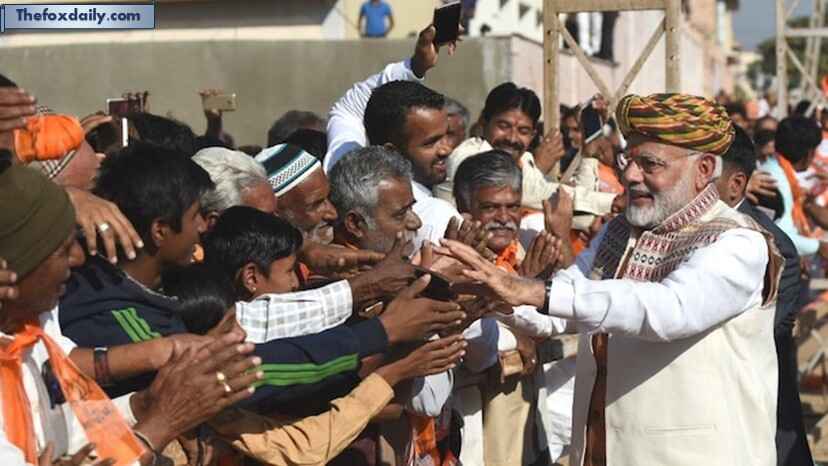
Modi Bets on Middle Class With GST Bachat Utsav and Income Tax Relief to Drive India’s Growth
After the people of India once again placed their faith in Prime Minister Narendra Modi by giving him a historic third term, the Prime Minister is now returning that trust by empowering citizens directly. Instead of relying solely on corporates, Modi is shifting focus towards strengthening India’s middle class by putting more money in their hands. With relief on both income tax and GST, the government expects to unlock higher purchasing power and accelerate the engine of private consumption—the backbone of the Indian economy.
In his national address on Sunday, Modi announced the launch of the “GST Bachat Utsav”, beginning on September 22, as part of the new tax regime. The Prime Minister highlighted how the reforms are designed to benefit the poor, the neo-middle class, and especially the middle class. The GST rate rationalisation, which kicks in today, comes right after the income tax relief measures introduced in the Union Budget 2025–26, making it a double boost for households across the country.
Strengthening the Consumption Engine of India
The core objective of the twin tax relief measures is to boost the purchasing power of India’s middle class. Since consumption drives the Indian economy, which contributed 61.4% of nominal GDP in FY 2024–25, the government is betting big on this strategy to accelerate growth. By easing the financial burden, Modi aims to ensure families have more disposable income, which in turn can fuel demand for goods and services across sectors.
During his address, Modi underlined that the combined impact of income tax relief and GST Reforms would allow the people of India to save over ₹2.5 lakh crore annually. This move also marks a clear departure from the earlier approach of extending benefits to large corporations, which failed to translate into broad-based economic growth.
Why Corporate Tax Cuts Failed to Deliver
Back in September 2019, the Modi government tried to ignite growth by reducing the corporate tax rate from 30% to 22%. The expectation was that this relief would help industries invest in capacity expansion, create jobs, and increase wages. However, despite enjoying 15-year-high profits, corporates largely pocketed the gains instead of passing them down to workers or investing in meaningful job creation.
The revenue loss for the government was steep—amounting to ₹1.84 lakh crore across FY 2019–20 and FY 2020–21. Unfortunately, this policy shift yielded no visible boost in consumption or wages. Adding to the irony, corporate tax contributions fell behind personal income tax collections. In FY 2023–24, corporate tax revenues were ₹9.11 lakh crore, while individual taxpayers contributed ₹10.44 lakh crore, highlighting the growing burden carried by ordinary citizens over large companies.
Middle Class Becomes the New Growth Driver
Realising the shortcomings of corporate tax breaks, the Modi government has now placed its faith in India’s middle class and neo-middle class as the new growth engines of the economy. As economist Tiwari notes, “For demand to grow, income has to grow. The planned GST relief will leave more money in the hands of people and boost consumption.”
While the GST rate rationalisation is expected to cost the government around ₹48,000 crore annually, experts argue that this money will eventually re-enter the economy through increased demand. As more goods and services are consumed, the government stands to recover at least 10% of these losses through GST revenues.
The Expanding Neo-Middle Class: A Key to India’s Future
The Modi government has consistently emphasised the role of the middle class in India’s growth story. Currently, only 140 million people, or around 10% of India’s population, have the ability to buy discretionary goods and services. However, the emergence of a neo-middle class is reshaping this equation. Over the past few years, around 25 crore Indians have successfully moved out of poverty, forming a rapidly growing consumer base with aspirations, ambitions, and spending capacity.
Prime Minister Modi highlighted this in his address: “Our country’s poor, middle class, neo-middle class, youth, farmers, women, shopkeepers, traders, entrepreneurs—all of them will benefit greatly from this Savings Festival.” By recognising their role, the government hopes to push India into a higher consumption-driven growth cycle.
Viksit Bharat 2047: A Vision Powered by the Middle Class
By reducing both income tax and expenditure tax (GST), the government is directly boosting household incomes and savings. The philosophy is simple—the more people save, the more they will spend, thereby creating a multiplier effect on the economy. This strategy aligns with Modi’s long-term vision of achieving Viksit Bharat by 2047, which requires India to sustain a GDP growth rate of at least 8% annually.
The shift in approach—from relying on corporates to trusting India’s middle class—is not just a political signal but also an economic necessity. Corporates failed to deliver on the government’s bet in 2019, but the growing middle class, armed with stronger purchasing power, is expected to deliver the consumption push required to keep India’s growth story alive. The GST Bachat Mahotsav that kicks off today is a powerful symbol of this trust and the government’s renewed focus on empowering households as the true drivers of India’s economy.
For breaking news and live news updates, like us on Facebook or follow us on Twitter and Instagram. Read more on Latest India on thefoxdaily.com.




COMMENTS 0